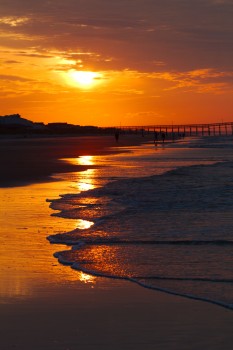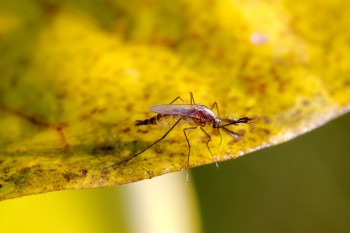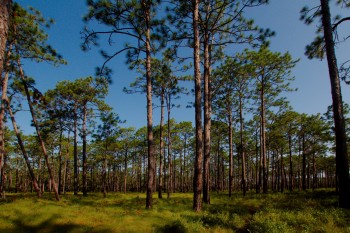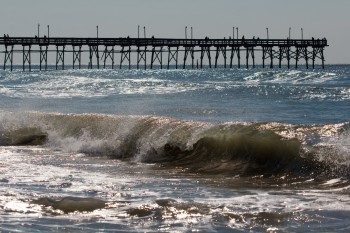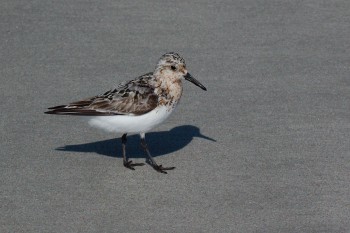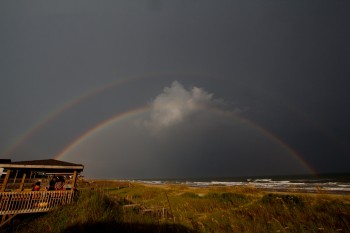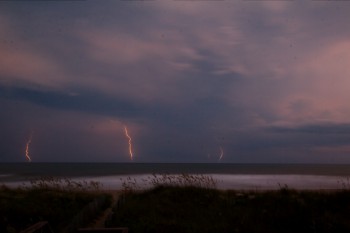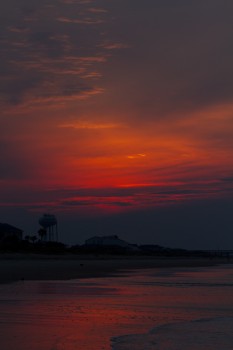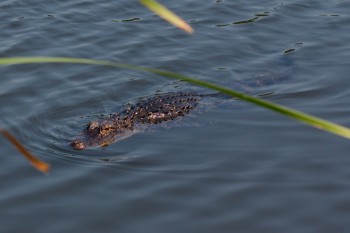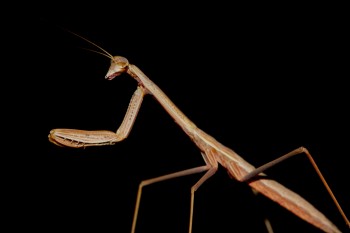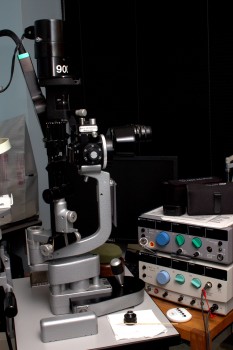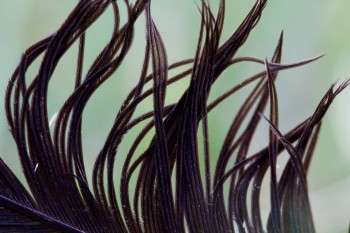This isn’t a great picture, but I wanted to post it because I had never seen one of these before and I think it’s pretty cool looking. It’s a species of velvet ant (Family Mutillidae) called a cow killer (Dasymutilla occidentalis). They are called this because of the very painful sting they can give. They are technically wasps, but since they are seen on the ground and in many ways look more like ants, the are commonly called ants. They are quite large, almost 2cm long, bright orange and black, and hairy. This one was on the move and I had a hard time getting the image in focus as it moved along. This one, with it partially blocked by a blade of grass, was the best of a blurry lot.
Monthly Archives: July 2014
Cow Killer (Dasymutilla occidentalis, a Velvet Ant)
Sunrise, Ocean Isle Beach
Those of you who follow me on the various social media outlets of the interwebs have already seen a picture of this sunrise, which I took on my phone and posted the morning of July 31. Unsurprisingly, I took some pictures with my “real” camera, as well, and I’m pretty pleased with how they turned out, as well. It’s actually somewhat amazing how good the phone pictures is, but there are still things I can do with my Canon that the Samsung won’t quite manage.
I was going through the images I took and trying to decide which I like best, which is sometimes really easy. Today, though, there were two that I liked and I was having a hard time picking between them. On the one hand, I think this vertical photo is the better image of the sun, the reflection, and the waves. On the other hand, I really like the bird in the first one. In fact, I was thinking about cropping that down to just have the bird, the streak of light from the sun, and the top of the wave coming up the beach. I may do that yet for a card, but this is the whole image.
This is the third and final sunrise that I’ll post from Ocean Isle this year. They were all quite different from one another, which is, I think, one of the things we find so fascinating about sunrises. That and their evanescence. They have to be enjoyed in the moment, because they don’t wait, evaporating like a morning mist. Pictures are nice, of course, but they don’t hold a candle to the real thing. Standing in the waves of the Atlantic, feeling the cool, morning breeze on my face, and seeing the colors and movement of those waves, most of that is lost in the photograph.
Green Swamp
I have a largish collection of pictures to post for today but I’m putting them in a single post, because they were all taken at the same place. When we were at the beach few years ago we went to the Green Swamp, north of Supply, North Carolina, because of an article I happened to see in Smithsonian magazine. The article was about Venus flytraps and this is one of the places to which they are native. We had a mostly good experience on that first visit, although we learned a few important lessons, not the least of which is that there are significant biting insects there. Hey, it’s a swamp, it’s going to have bugs.
Mostly we go for the plant life. The main attraction is the collection of carnivorous plants, including but no limited to the Venus flytrap (Dionaea muscipula). My first picture above is a meadow beauty (Rhexia virginica) and they are scattered around the swamp, particularly the first areas you walk through when leaving the small parking area on NC 211. After walking on a boardwalk through the first pocosin, a heavily wooded wetland area, into the next area of (higher and dryer) long-leaf pine savanna, there are Venus flytraps. The are a little hard to find until you’re found a couple and really know what to look for. Then you start to see them everywhere.
Back to the biting insects a bit. Many of the pitcher plants have a green lynx spider (Peucetia viridans) living on or around them. Because the plants attract insects, it’s a particularly good place for a spider to live, especially one that doesn’t spin a web and hunts for insects “the old fashioned way.” This is the top of a pitcher plant, there is a piece of leaf called an operculum which acts as a hood to the pitcher. Apparently there isn’t a lynx spider on this one, or this mosquito would probably not have lasted so long. Usually I don’t let mosquitoes hang around without being swatted but this one posed for me very nicely. As long as it didn’t land on me, I decided I would let it live. (UPDATE—2014/08/14: This has been identified as a male Ochlerotatus atlanticus. I know you’ve all been waiting with baited breath to learn that.)
I did see lynx spiders, though. Both on pitcher plants and on this thistle bud. I like this picture for it’s color and simplicity. These spiders are quite ferocious looking up close, with spines all over their legs and their bright green color, which makes them a bit difficult to see sometimes, as they blend in with their leafy surroundings.
When I got my camera set up, this one moved around to the far side of the thistle bud. I few gentle movements with my finger convinced her to move around to the camera side, however. I did take a few closer pictures that show more detail of the spider but I thought I’d go with this longer view, showing the whole flower. We also saw them on pitcher plants and I took some pictures of that, as well, but they didn’t turn out as nicely as this one, I think.
Here’s a wide angle view of the long-leaf pine savanna we were walking through. In this area are the eponymous long-leaf pines, of course. The most common plant is grass and since we came early this year, it was still quite wet with dew. Our pant legs were soaked long before we got this far into the swamp. You cannot really see them well in this picture but the yellow pitcher plants are scattered through the grass, reaching up through it. The smaller purple pitcher plants are harder to find, because they only grow about six inches tall, at most. Their flower stalk is usually the first thing you see, being much taller than the pitchers.
On the way out of the swamp we stopped by the pond near the parking area to take pictures of pitcher plants. They grow in the very wet area right on the edge of the pond. They may grow in other areas of the swamp but this is the only place we’ve seen them. They are quite small and it really helps to know what you’re looking for. The leaves of this spoonleaf sundew (Drosera intermedia) are only about 5mm across and the whole plant not much more than 4cm. They have very small, white flower, as well, but I didn’t get any pictures of them this year.
While I was taking pictures of the sundew, the others were enjoying a blue dasher dragonfly (Pachydiplax longipennis) who kept landing on the same twig, making it fairly easy to get close enough for a good picture. After they all had their pictures, they let me have a turn and I got this one, which I like pretty well.
So, another trip to the Green Swamp of North Carolina. If you go, try to pick a cool day and go early, before the sun gets too hot (we were done by 9:30 and it was starting to heat up by then). Put on a lot of deet-based bug repellent and be ready to swat those that ignore it. I prefer long trousers and sleeves, even though it’s hot, because of the bug protection. But be sure to bring a camera, because there’s lots to see.
Starry Night
The last photo from another busy day. This one isn’t as spectacular as the thunderstorm photo from last night, but I’m still pretty pleased with it. Dorothy suggested that I go out and take some pictures, because the southern sky was so clear and the Milky Way was clearly visible. Well, clear is relative and this was clear if you are used to the east cost of North America, anyway. This was taken with settings similar to last night’s, with the ISO set to 640, f/3.5 and 30 seconds. The lens was a 10–20mm zoom, at 10mm, so a fairly wide angle (that’s equivalent to 16mm on an old 35mm camera, for anyone who actually remembers those). This picture was harder to deal with in terms of “noise.” If I reduced it enough to matter, I lost a lot of the detail in the Milky Way. So, here’s an even better reason to want a full frame SLR. And a trip to the dry, much clearer and darker parts of the country, preferably on the top of a mountain. Still, it’s the best Milky Way picture I’ve ever taken (though that’s not saying much).
Ocean Isle Pier
Shortly after I took the picture of the little sandpiper, on the same walk down the beach, actually, I took this picture of the Ocean Isle Beach pier. I can’t actually remember the last time we’ve gone out on the pier, actually. I guess I don’t see much need. It does add a point of reference when you’re on the beach, though, and give a handy turning around point when walking.
I like the drama in this picture, of the crashing wave. It’s nothing to the waves in the surfing destinations around the world, but it’s a good enough wave for riding and no so big that you are in any danger when out, particularly on days as calm as this.
Sanderling (Calidris alba)
Here’s another bird photo. I’m not sure but I think this is an immature sanderling (Calidris alba). There are quite a few little sandpipers and they all look very much alike. When you throw in variations, it’s quite hard to tell them apart. Anyway, this is one of them. I love to watch them run around, avoiding the incoming waves, and then running back down where the sand is wet and soft, looking for things to eat.
A Very Different Sunrise
After the dark, deeply colored sunrise I took on July 28, today’s was very different. There wasn’t a lot of pink, orange, or red in the sky, just a little around the sun. But the clouds were quite pretty and nicely reflected in the water washing up on the beach. Also, after two days of 90°F plus heat, I woke up to about 70°F this morning. It warmed up later in the day but never really got above about 82°F. It was much less humid, as well. Beautiful.
Storm and Stars
After seeing the beautiful rainbow and then going out to take pictures of the receding storm over the ocean, I figured that was all the pictures I’d take for the day. I did go next door to snap a few pictures of my aunt and uncle and their family, a group of 18. As I came out from that, I was greeted with a beautiful sight. Even this photograph, which I think it pretty amazing, doesn’t capture the real beauty. The sky would be dark. Then, lightning in the clouds out to sea would light them up, sometimes just providing light to the clouds, other times accompanied by streaks of lightning between the clouds and the sea or horizontally between clouds. I set up my camera on a tripod and took a bunch of exposures at various settings. This one was ISO 800, f/3.5, 30 seconds. On the beach, you can see a family with flashlights walking from right to left. Then, the clouds, lit by multiple flashes of lightning. Above the clouds, stars.
Long exposures on a digital camera produces a lot of “noise.” The black areas of the picture were not black, but a mottled collection of colored blobs, small but of varying size. This is a time when a full-frame sensor makes a big difference, because they produce significantly less noise. Still, with the aid of a noise filter on my processing software, I’ve turned this into something usable. I’m pretty chuffed about this picture, to be honest.
Rainbow and Evening Storm
Two more pictures for today. A little before 6:00 PM we all went outside to see a very full and then a full double rainbow across the eastern sky. As you can see, I was able to capture the entire length of it with my wide angle lens. Although you cannot quite make it out in this picture, in addition to the secondary rainbow, outside the first, we saw a supernumerary, extra arcs just inside the main rainbow. It was quite a show.
As the storm moved out to sea, the lightning didn’t abate. If anything, it got more frequent. I set up my camera on the railing of our deck and took some pictures of the clouds. By closing the aperture down and setting the ISO to 100, I was able to get long exposures times. This one was 25 seconds at f/22. That let me capture a few bolts of lightning in a single frame, which is pretty exciting. I like thunderstorms at most times but at the beach they really do tend to be spectacular.
Willet (Tringa semipalmata)
I have a few pictures to post today and thought I’d spread them out a bit rather than putting them into one long post. They are someone disconnected, in any case. The first picture was of a sunrise, this next one, taken a bit after 2:00 PM, is of a willet (Tringa semipalmata), a fairly common shore bird in these parts. They can be seen pretty much anywhere along the beach and seem to be after the little sand crabs (in the genus Emerita). They aren’t the shyest birds on the beach but it’s hard to get very close to them, as they are always on the move and quite willing to fly away or around you if you get too close.
Sunrise, Ocean Isle Beach
As is fairly common at the beach, there was a pretty sunrise this morning. Most of our house was still in bed, but my body rarely lets me sleep much past 6:00 (and sometimes not even that late). It’s one of the “benefits” of getting old, I guess. Anyway, I came down stairs and soon noticed a bit of color in the sky so I grabbed my camera and went out for a few photographs. The house we’re staying in has a room without air conditioning, which for those of use with cameras, is a nice thing. Going from a cold house to a warm, very humid beach is a good way to have your camera fog up. This is especially true first thing in the morning, and by the time you’re ready to take pictures, the light is gone. This sunrise color didn’t last very long but was particularly intense when I went out.
Alligator
We went for a drive this morning, giving Dorothy a little driving time. We went a little way into South Carolina before turning around. On the way back we stopped at a pond between a golf course and the road. There is a wildlife viewing platform built there, although the bushes between it and the pond make it difficult to see much of anything. Just past the end of the platform there is an opening in the bushes and we saw a pair of American alligators (Alligator mississippiensis).
Karlee and Dorothy
At Ocean Isle Beach there is a church service on the beach each Sunday morning. We’ve meant to go before but this year we actually did. I took this picture of Karlee and Dorothy shortly after the service ended. It was a good way to start the week. Karlee has been to the beach with us every year that we’ve gone since the summer after she and Dorothy were in fourth grade together. We didn’t go in 2007 because we were in Greece and in 2009 we were in Boston for Steve and Maya’s wedding, but all the other years since 2006. Karlee has been to family reunions and actually knows Dorothy’s second and third cousins about as well as Dorothy does. She is definitely one of the family.
Sea Oats (Uniola paniculata)
Traveling tends to make getting different pictures for my blog much easier, because I’m not looking at the same things and driving the same routes that I usually see and drive. The only difficulty is that while I’m actually driving, taking pictures is pretty much out of the question, particularly when driving 70 miles per hour on I-95, which is not the most relaxing highway in the country. We left early today, arriving at our destination before the big traffic jam extends over the bridge and well onto the mainland. The only pictures I took today were from a walk on the beach and included this one of sea oats (Uniola paniculata), growing on the dunes between our rental and the ocean.
As I’m writing this after we returned from the beach I can assure you that we had a great time and I got some more interesting pictures than this.
Tenodera sinensis (Chinese Mantis)
Cathy and I were out back this evening and she spotted this mantis on one of the chairs on our patio. I think (but I’m by no means sure) that it is a Chinese mantis (Tenodera sinensis), which were introduced here from China in 1896 to combat pests. This is a smallish one, only about two and a half inches long. It was getting a bit dark and the pictures I took by available light were not very good, so I turned on the flash and got a few pictures that are reasonably good, with the mantis standing out well against the dark background.
Laser Retina Repair
I visited my retina specialist today. The appointment was set up before I even had the cataract surgery scheduled but because of that surgery and the problems I had last week, I was glad to have it set up. The doctor saw a small piece of retina that was torn, so he had me wait a little while and give it a blast with his laser. This is not the greatest picture because of the dark background, but it shows the equipment he uses for this procedure. The box on the right (the lower one) controls the laser mounted on the slit lamp. He gave my eye 41 pulses of the laser to weld my retina to the underlying choroid layer of my eye. Afterward they took a photo of my eye that shows the site and I asked the technician to email me the picture, which is pretty cool. I won’t say I enjoy having a laser shined into my eye, but when it’s a choice between that and a detached retina, I’ll take the laser.
Turn Left
Dorothy was driving home this evening and I was in the passenger seat so I pulled out the camera and took some long exposure images of signs and lights as we went past. This is sort of a hit or miss process with a lot more misses than hits. One problem is that when the shutter is open, the viewfinder goes black. If you are moving (as we were in the car) it is difficult to keep the camera aimed at any particular subject. These images are more interesting when there is some movement, anyway, but getting it under control is, to a great extent, chance.
Gray Catbird (Dumetella carolinensis)
I had sautéd octopus for breakfast this morning and took pictures of that, but if history tells me anything, pictures of cooking octopus aren’t as popular as some others that I take. In the early evening I was going out to take pictures and there was a catbird in the rose bush just outside our front door. I took a few pictures before he (or she) flew away, and thought that might be more acceptable.
Polistes dominula (European Paper Wasp)
I only took a few photographs in the back yard today, including a few of black-eyed Susans and then some of this European paper wasp (Polistes dominula). They aren’t the friendliest of wasps and I have to admit to being a little nervous of him. In general, the bees at the mountain mint (Pycnanthemum muticum) are unmindful of me but there are a few that I take with are, regardless. I think if you’ve ever been stung by one of these, you’d feel the same way.
Feather
Did you know that since the Migratory Bird Treaty Act of 1918 (16U.S.C. 703-712) it has been illegal for most people to collect most feathers. Unless you want to be a criminal, just let it lie. It’s a bit stupid, of course, and many people collect feathers without being indicted. It’s a good example of a “well meaning government” making life against the law and making criminals of all its citizens, in this case including (and especially) children.
Anyway, this is a feather. I think it’s pretty.



